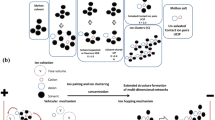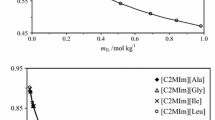Abstract
Electrical conductivities were measured for the ternary systems Y(NO3)3+La(NO3)3+H2O, La(NO3)3+Ce(NO3)3+H2O, La(NO3)3+Nd(NO3)3+H2O, and their binary subsystems Y(NO3)3+H2O, La(NO3)3+H2O, Ce(NO3)3+H2O, and Nd(NO3)3+H2O at (293.15, 298.15 and 308.15) K. The measured conductivities were used to test the generalized Young’s rule and the semi-ideal solution theory. The comparison results show that the generalized Young’s rule and the semi-ideal solution theory can yield good predictions for the conductivities of the ternary electrolyte solutions, implying that the conductivities of aqueous solutions of (1:3 + 1:3) electrolyte mixtures can be well predicted from those of their constituent binary solutions by the simple equations.
Similar content being viewed by others
Abbreviations
- a :
-
activity
- A l :
-
coefficients in Eq. 4
- B,C:
-
solute components
- I :
-
ionic strength
- m :
-
molality (mol⋅kg−1)
- N :
-
the number of experimental data
- x :
-
mole fraction
- y :
-
ionic strength fraction
- σ :
-
conductivity
- δ :
-
function defined by Eq. 6
- ϕ :
-
osmotic coefficient
- Δ:
-
function defined by Eq. 5
- io:
-
quantity in binary solutions at the same water activity as that of a mixed solution
- o:
-
quantity in binary solutions
- o,I :
-
quantity in binary solutions at the same ionic strength as that of a mixed solution
- B,C:
-
components
- calc:
-
calculational quantity
- Eq. i :
-
prediction of Eq. 2 or Eq. 3
- exp :
-
experimental quantity
- M i X i :
-
component index
- w:
-
water
References
Miller, D.G.: Binary mixing approximations and relations between specific conductance, molar conductance, equivalent conductance, and ionar conductance for mixtures. J. Phys. Chem. 100, 1220–1226 (1996)
Hu, Y.F., Lee, H.: Prediction of viscosity of mixed electrolyte solutions based on the Eyring’s absolute rate theory and the semi-ideal hydration model. Electrochim. Acta 48, 1789–1796 (2003)
Hu, Y.F.: Prediction of viscosity of mixed electrolyte solutions based on the Eyring’s absolute rate theory and the equations of Patwardhan and Kumar. Chem. Eng. Sci. 59, 2457–2464 (2004)
Yang, J.Z., Liu, J.G., Tong, J., Guan, W., Fang, D.W., Yan, C.W.: Systematic study of the simple predictive approaches for thermodynamic and transport properties of multicomponent solutions. Ind. Eng. Chem. Res. 49, 7671–7677 (2010)
Andrzej, A., Malgorzata, M.L.: Computation of electrical conductivity of multicomponent aqueous systems in wide concentration and temperature ranges. Ind. Eng. Chem. Res. 36, 1932–1943 (1997)
Scatchard, G.: The speed of reaction in concentrated solutions and the mechanism of the inversion of sucrose. J. Am. Chem. Soc. 43, 2387–2406 (1921)
Scatchard, G.: The hydration of sucrose in water solution as calculated from vapor-pressure measurements. J. Am. Chem. Soc. 43, 2406–2418 (1921)
Stokes, R.H., Robinson, R.A.: Ionic hydration and activity in electrolyte solutions. J. Am. Chem. Soc. 70, 1870–1878 (1948)
Robinson, R.A., Stokes, R.H.: Activity coefficients in aqueous solutions of sucrose, mannitol and their mixtures at 25 °C. J. Phys. Chem. 65, 1954–1958 (1961)
Stokes, R.H., Robinson, R.A.: Interactions in aqueous nonelectrolyte solutions. I. Solute–solvent equilibria. J. Phys. Chem. 70, 2126–2130 (1966)
Hu, Y.F.: The thermodynamics of nonelectrolyte systems at constant activities of any number of components. J. Phys. Chem. B 107, 13168–13177 (2003)
Hu, Y.F., Fan, S.S., Liang, D.Q.: The semi-ideal solution theory for mixed ionic solutions at solid-liquid-vapor equilibrium. J. Phys. Chem. A 110, 4276–4284 (2006)
Young, T.F., Wu, Y.C., Krawetz, A.A.: Thermal effects of the interactions between ions of like charge. Discuss. Faraday Soc. 24, 37–42 (1957)
Hu, Y.F., Zhang, Z.X., Zhang, Y.H., Fan, S.S., Liang, D.Q.: Viscosity and density of the nonelectrolyte system mannitol + sorbitol + sucrose + H2O and its binary and ternary subsystems at 298.15 K. J. Chem. Eng. Data 51, 438–442 (2006)
Hu, Y.F.: New Predictive equations for the specific and apparent molar heat capacities of multicomponent aqueous solutions conforming to the linear isopiestic relation. Bull. Chem. Soc. Jpn. 74, 47–52 (2001)
Wu, Y.C., Koch, W.F., Zhong, E.C., Friedman, H.L.: The cross-square rule for transport in electrolyte mixtures. J. Phys. Chem. 92, 1692–1695 (1988)
Hu, Y.F., Zhang, X.M., Li, J.G., Liang, Q.Q.: The semi-ideal solution theory. 2. Extension to conductivity of mixed electrolyte solutions. J. Phys. Chem. B 112, 15376–15381 (2008)
Spedding, F.H., Pikal, M.J., Ayers, B.O.: Apparent molal volumes of some aqueous rare earth chloride and nitrate solutions at 25 °C. J. Phys. Chem. 70, 2440–2449 (1966)
Spedding, F.H., Cullen, P.F., Habenschuss, A.: Apparent molal volumes of some dilute aqueous rare earth salt solutions at 25 °C. J. Phys. Chem. 78, 1106–1110 (1974)
Zdanovskii, A.B.: Regularities in the property variations of mixed solutions. Tr. Sol. Lab. Akad. Nauk SSSR 6, 5–70 (1936)
Hu, Y.F., Zhang, X.M., Jin, C.W., Peng, X.M.: The semi-ideal solution theory. 3. Extension to viscosity of multicomponent aqueous solutions. J. Solution Chem. 39, 1828–1844 (2010)
Rard, J.A., Miller, D.G., Spedding, F.H.: Isopiestic determination of the activity coefficients of some aqueous rare earth electrolyte solutions at 25 °C. 4. La(NO3)3, Pr(NO3)3, and Nd(NO3)3. J. Chem. Eng. Data 24, 348–354 (1979)
Rard, J.A., Spedding, F.H.: Isopiestic determination of the activity coefficients of some aqueous rare earth electrolyte solutions at 25 °C. 6. Eu(NO3)3, Y(NO3)3, and YCl3. J. Chem. Eng. Data 27, 454–461 (1982)
Ruas, A., Simonin, J.P., Turq, P., Moisy, Ph.: Experimental determination of water activity for binary aqueous cerium(III) ionic solutions: application to an assessment of the predictive capability of the binding mean spherical approximation model. J. Phys. Chem. B 109, 23043–23050 (2005)
Rard, J.A., Spedding, F.H.: Electrical conductances of some aqueous rare earth electrolyte solutions at 25 °C. III. The rare earth nitrates. J. Phys. Chem. 79, 257–262 (1975)
Hu, Y.F., Peng, X.M., Jin, C.W., Liang, Y.G., Chu, H.D., Zhang, X.M.: The semi-ideal solution theory. 4. Applications to the densities and conductivities of the mixed electrolyte and nonelectrolyte solutions. J. Solution Chem. 39, 1597–1608 (2010)
Hu, Y.F., Jin, C.W., Ling, S., Zhang, J.Z.: Densities of the ternary systems Y(NO3)3+Ce(NO3)3+H2O, Y(NO3)3+Nd(NO3)3+H2O, and Ce(NO3)3+Nd(NO3)3+H2O and their binary subsystems at different temperatures. J. Chem. Eng. Data 55, 5031–5035 (2010)
Wang, Z.C., He, M., Wang, J., Li, J.L.: Modeling of aqueous 3–1 rare earth electrolytes and their mixtures to very high concentrations. J. Solution Chem. 35, 1137–1156 (2006)
Author information
Authors and Affiliations
Corresponding author
Electronic Supplementary Material
Below is the link to the electronic supplementary material.
Rights and permissions
About this article
Cite this article
Hu, YF., Jin, CW., Zhang, JZ. et al. Conductivities of the Ternary Systems Y(NO3)3+La(NO3)3+H2O, La(NO3)3+Ce(NO3)3+H2O, La(NO3)3+Nd(NO3)3+H2O and Their Binary Subsystems at Different Temperatures. J Solution Chem 40, 1447–1457 (2011). https://doi.org/10.1007/s10953-011-9726-y
Received:
Accepted:
Published:
Issue Date:
DOI: https://doi.org/10.1007/s10953-011-9726-y




